|
Vanellus armatus (Blacksmith
lapwing, Blacksmith plover)
Bontkiewiet [Afrikaans]; iNdudumela [Zulu]; Runkerenkere
(generic term for lapwing) [Kwangali]; Mo-otla-tšepe [South Sotho]; Ghelekela
(generic term for plover) [Tsonga]; Lethulatshipi [Tswana]; Smidsplevier
[Dutch]; Vanneau armé [French]; Waffenkiebitz, Schmiedekiebitz [German];
Abibe-preto-e-branco [Portuguese]
Life
> Eukaryotes >
Opisthokonta
> Metazoa (animals) >
Bilateria >
Deuterostomia >
Chordata >
Craniata > Vertebrata (vertebrates) > Gnathostomata (jawed
vertebrates) > Teleostomi (teleost fish) > Osteichthyes (bony fish) > Class:
Sarcopterygii (lobe-finned
fish) > Stegocephalia (terrestrial
vertebrates) >
Tetrapoda
(four-legged vertebrates) > Reptiliomorpha > Amniota >
Reptilia (reptiles) >
Romeriida > Diapsida > Archosauromorpha > Archosauria >
Dinosauria
(dinosaurs) > Saurischia > Theropoda (bipedal predatory dinosaurs) >
Coelurosauria > Maniraptora > Aves
(birds) > Order: Charadriiformes
> Family: Charadriidae > Genus:
Vanellus
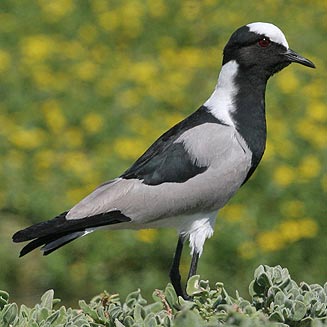 |
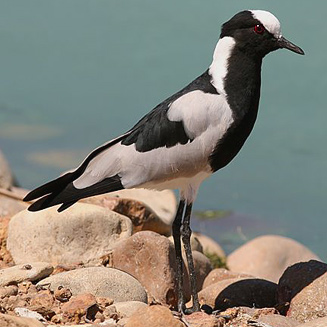 |
|
Blacksmith lapwing, Strandfontein Sewerage Works,
Western Cape, South Africa. [photo
Duncan Robertson
©] |
Blacksmith lapwing, Paarl Bird Sanctuary, South
Africa. [photo Trevor Hardaker ©] |
Distribution and habitat
Endemic to sub-Saharan Africa, occurring from Kenya through Tanzania
to southern DRC, Angola and Zambia to southern Africa. Within southern Africa it
is common in Namibia, northern Botswana, Swaziland, South Africa and
western Mozambique. It generally prefers moist, short grassland, mudflats around dams,
sewage pans, lakes, rivers, estuaries, salt pans, road verges, sports fields,
airports and heavily grazed areas.
|
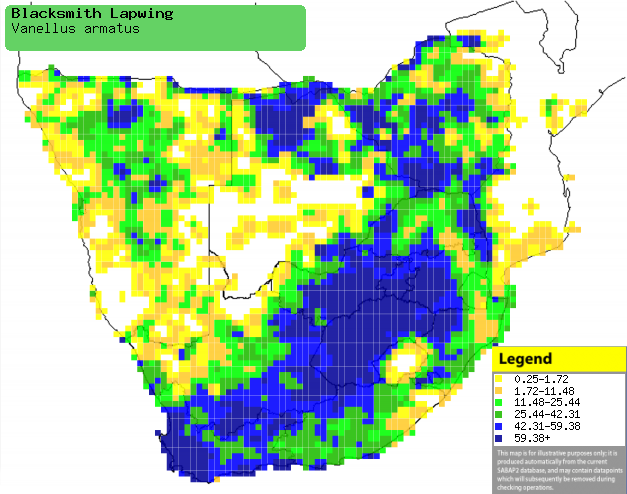 |
|
Distribution of Blacksmith lapwing in southern Africa,
based on statistical smoothing of the records from first SA Bird Atlas
Project (©
Animal Demography unit, University of
Cape Town; smoothing by Birgit Erni and Francesca Little). Colours range
from dark blue (most common) through to yellow (least common).
See here for the latest distribution
from the SABAP2. |
Predators and parasites
- Predators of chicks and eggs
Movements and migrations
It can be sedentary, nomadic or migratory
depending on environmental conditions, as for example in
particularly dry years it often moves from arid regions to areas
with more rainfall, vice versa in high rainfall years. It is
mainly sedentary when breeding, while it is often nomadic in the
non-breeding season.
Food
It eats aquatic and terrestrial invertebrates,
doing most of its foraging early and late in the day, standing still
while intently scanning for prey; once spotted it dashes forward to
pluck the animal from the surface of the ground or water. It also
searches for insect larvae in dung, sometimes trembling its foot in
shallow water to attract prey to the surface. The following food items have been recorded
in its diet:
- Invertebrates
- molluscs
- worms
- crustaceans
- insects
- Vertebrates
Breeding
- Usually a monogamous, territorial solitary nester, although
polygyny is rarely recorded.
- The nest (see image below) is a simple scrape or hoofprint in the ground,
usually lined with vegetation, stones and mud flakes, often
placed close to water. If the ground is wet the nest is a more
substantial mound, to reduce the risk of flooding destroying the
eggs.
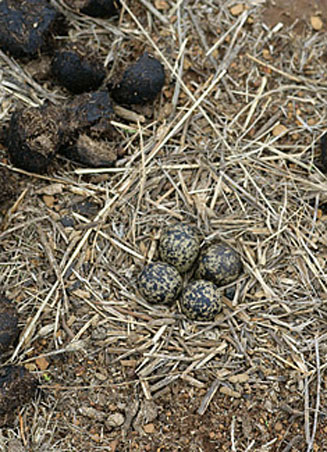 |
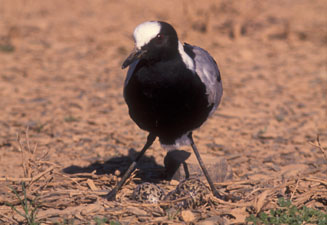 |
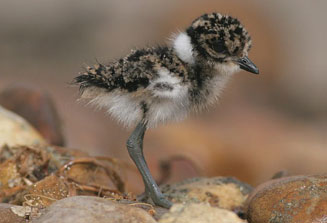 |
|
Blacksmith lapwing nest with eggs, Machadadorp,
South Africa. [photo
Warwick Tarboton ©] |
Top right: Blacksmith lapwing. [photo Peter Steyn
©]
Bottom right:
Blacksmith lapwing chick, Paarl Bird Sanctuary, South Africa. [photo
Trevor Hardaker ©] |
- Egg-laying season is year-round, peaking from July-October.
- It lays 1-4 eggs, which are incubated by both sexes for
about 26-33 days, typically in shifts of about 20-80 minutes.
- The chicks leave the nest within hours of hatching, after
which they remain within 10 metres of their parents, so that
they can warn their young when predators approach. As times goes
by they gradually range further away from the adults, fledging
at about 40 days old and usually becoming fully independent
about a month later.
Threats
Not threatened, in facts its range and
population dramatically increased in the 1900s.
References
-
Hockey PAR, Dean WRJ and Ryan PG 2005. Roberts
- Birds of southern Africa, VIIth ed. The Trustees of the John Voelcker
Bird Book Fund, Cape Town.
|
